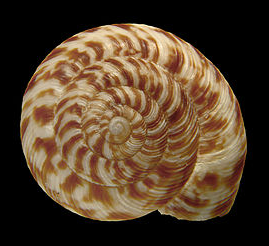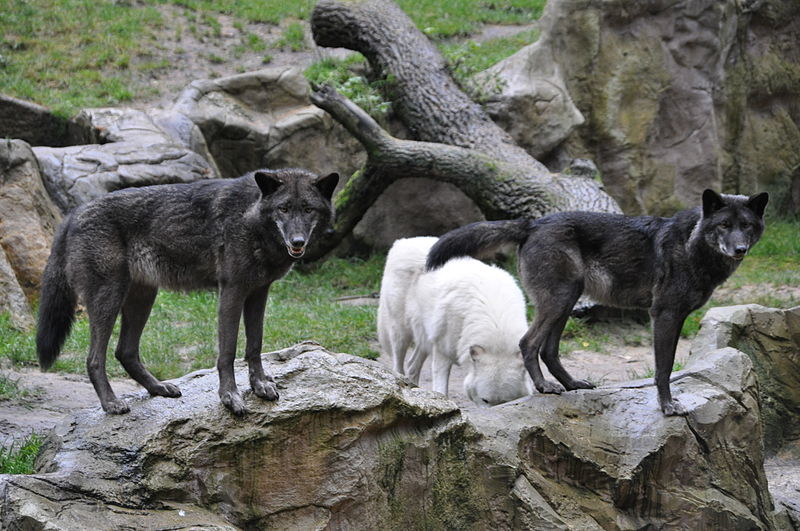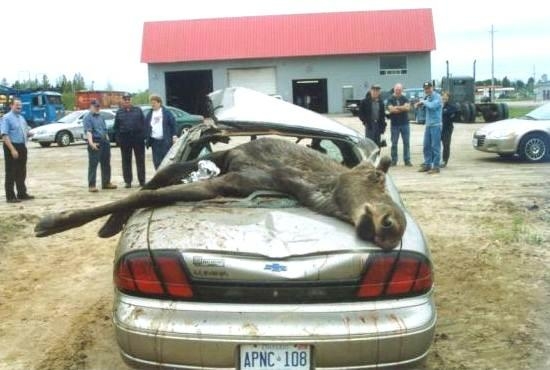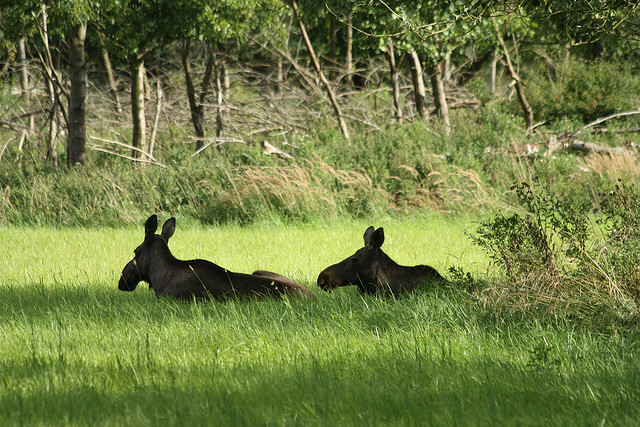
Interactions
The moose has many interactions with other organisms in its habitat. For example, the moose is on the negative end of a parasitic relationship with Dermacentor abaensis, also known as the “moose tick”. The moose tick stays attached to the host moose for its entire life cycle. They don’t infect the moose host with diseases, but they can eventually cause death due to emaciation and hypothermia. Another interaction that the moose has with a parasite is the parasitic relationship with the tapeworm Taenia hydatigena. This tapeworm causes liver cysts in the moose.
 The most prominent parasite the moose faces is
Parelaphostrongylus tenuis. Also called “the
brainworm”, this parasite starts its life cycle in deer, which it
does not affect, then is excreted from the deer with its feces. The
parasite then invades snails that are near the deer feces. The snail
that it usually infects is the
Flamed Tigersnail (Anguispira alternata). Once the
snail is infected, it travels to either trees or shrubs and is
accidently eaten by moose. Once inside the moose, the brainworm
affects the moose by attacking the moose’s brain and nervous system,
causing the moose to lose its fear of hazards. Seriously affected
moose will wander into cities, walk on roads, and even approach
humans. Eventually the brainworm will paralyze the moose completely
and it will eventually die of thirst or become an easy meal for
predators.
The most prominent parasite the moose faces is
Parelaphostrongylus tenuis. Also called “the
brainworm”, this parasite starts its life cycle in deer, which it
does not affect, then is excreted from the deer with its feces. The
parasite then invades snails that are near the deer feces. The snail
that it usually infects is the
Flamed Tigersnail (Anguispira alternata). Once the
snail is infected, it travels to either trees or shrubs and is
accidently eaten by moose. Once inside the moose, the brainworm
affects the moose by attacking the moose’s brain and nervous system,
causing the moose to lose its fear of hazards. Seriously affected
moose will wander into cities, walk on roads, and even approach
humans. Eventually the brainworm will paralyze the moose completely
and it will eventually die of thirst or become an easy meal for
predators.
 A few predators of the moose include the grizzly bear (Ursus
arctos), timber wolves (Canis lupus), the black bear (Ursus
arnericanus), and humans. Since a moose in its prime is almost
impossible to kill for bears and wolves, they tend to target the
weak, old, or young calves. Bears and wolves use their powerful
bodies and sharp claws and teeth to take down a moose. They try to
inflict as much pain as they possibly can without putting themselves
in danger. The moose can defend itself pretty well by kicking and
swinging its legs and antlers. Another potential threat to moose is
the coyote (Canis
latrans). Although an adult moose is big enough to not
worry about coyotes, the calves have to watch out for them. Coyotes
only attack baby moose if the opportunity is right. If they aren't
careful, they could die from the cow. Usually if the coyote eats any
moose, it's because it found a dead moose in the forest.
A few predators of the moose include the grizzly bear (Ursus
arctos), timber wolves (Canis lupus), the black bear (Ursus
arnericanus), and humans. Since a moose in its prime is almost
impossible to kill for bears and wolves, they tend to target the
weak, old, or young calves. Bears and wolves use their powerful
bodies and sharp claws and teeth to take down a moose. They try to
inflict as much pain as they possibly can without putting themselves
in danger. The moose can defend itself pretty well by kicking and
swinging its legs and antlers. Another potential threat to moose is
the coyote (Canis
latrans). Although an adult moose is big enough to not
worry about coyotes, the calves have to watch out for them. Coyotes
only attack baby moose if the opportunity is right. If they aren't
careful, they could die from the cow. Usually if the coyote eats any
moose, it's because it found a dead moose in the forest.
The predator-prey relationship between moose and wolves works in a cycle. If the moose are abundant, then more wolves will be able to live due to the moose population being so high. Once the wolves’ population increases, they start to kill off many moose, causing their population numbers to plummet. Once this happens, some of the wolves starve due to there being less moose to go around. As you can see, the moose and the wolves are in a predator-prey cycle.
 Moose are also affected by humans due to car crashes. At night, a
moose blends in well with a dark road because of its dark, brown
fur. Also, unlike deer, moose eyes don’t reflect light when the
headlights are shining at them. This combination can lead to a
disastrous car crash. Most cars will usually take out a moose at the
legs and cause the body of the moose to come crashing into the
windshield. That is a lethal combination for the passengers of the
car and also the moose.
According to
the Associated Press in 2009, 130 moose are fatally hit by a car in Anchorage, Alaska
every winter on average.
Moose are also affected by humans due to car crashes. At night, a
moose blends in well with a dark road because of its dark, brown
fur. Also, unlike deer, moose eyes don’t reflect light when the
headlights are shining at them. This combination can lead to a
disastrous car crash. Most cars will usually take out a moose at the
legs and cause the body of the moose to come crashing into the
windshield. That is a lethal combination for the passengers of the
car and also the moose.
According to
the Associated Press in 2009, 130 moose are fatally hit by a car in Anchorage, Alaska
every winter on average.
Fungi and bacteria play key part in the digestive system of the moose. Members of the Spizellomyces genus are the main fungi that help break down cellulose in the ingested vegetation. Fungi and bacteria, mainly bacteria, digest vegetation that is ingested when the food reaches the rumen. The most common and abundant bacteria genus that lives in the anaerobic environment inside of the rumen is the Butyrivibrio genus.
 Moose interact with plant species all the time. They are usually
eating them, using them to help remove velvet, using them to help
digestion, or simply walking over them. An example of a plant that a
moose interacts with is
Larix Laricina, also known as the tamarack. On the other
hand, moose hardly ever interact with other moose. They tend to stay
to themselves and are very independent. The only time they interact
together is when food is hard to find in the winter and when they
are in the rut. The moose has many interactions with all sorts of
species and is a vital part to the ecosystem in the taiga.
Moose interact with plant species all the time. They are usually
eating them, using them to help remove velvet, using them to help
digestion, or simply walking over them. An example of a plant that a
moose interacts with is
Larix Laricina, also known as the tamarack. On the other
hand, moose hardly ever interact with other moose. They tend to stay
to themselves and are very independent. The only time they interact
together is when food is hard to find in the winter and when they
are in the rut. The moose has many interactions with all sorts of
species and is a vital part to the ecosystem in the taiga.

Moose also with cross paths with a few of its "family" members once in awhile. By "family", I am talking about the family Cervidae! While a moose is just browsing leaves and walking through the forest, it can cross paths with the Roosevelt elk (Cervus canadensis roosevelti) and the reindeer (Rangifer tarandus). When these species get close enough, they both detect a disturbance in the forest around them. At this point, the elk and reindeer usually run away. The moose just stands its ground. The moose only runs when it needs too. These species are in a competitive relationship with each other for territory and food.
Not enough information for you? Go to Facts and Glossary to find fun facts and definitions!
Back to Homepage